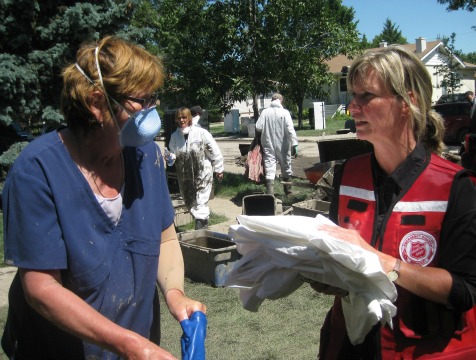After the Flood: A Woman Rebuilds in High River

One by one their homes were overtaken by water. They were powerless to respond. Now, unsure of the future, residents like Kathleen are cleaning-up, trying to get back on their feet.
On June 20, 2013, High River, AB, declared a state of emergency when torrential rains and widespread flooding washed out roads and bridges, cars, couches and appliances, and sent residents racing to safety. The flood was described by the provincial government as the worst in Alberta’s history.
Devastation
Ten days after the disaster, officials from this town of 13,000 deemed Kathleen’s log home safe for re-entry.
“You are just not prepared for this,” says the 62-year-old of the condition of her home. At the back of the house the basement wall had collapsed. Its contents were strewn about, floating in dirty brown water. Inside, the filthy water had bubbled through the Fir wood floors destroying furniture and appliances. Muck, slippery and inches thick, made walking and clean-up slow and difficult.
Hope in the Rubble
Covered in sludge and wearing a mask because mud and water had contaminated her home, Kathleen watched as volunteers carried out her belongings, much of them slathered in mud and unidentifiable.
“What is it, I wonder?” she asks one volunteer, who shows her a bag with matted, mucky contents inside. It was her late father’s ties that she’d planned to make a quilt from.
Minutes later another volunteer cups in his hands a goldfish covered in muck, and gills not moving. It was found in the basement and Kathleen suspects it is from the neighbour’s pond. She stops in her tracks when she puts it in a Tupperware container with clean water and it swims.
“This gives me hope,” she tells Salvation Army disaster relief personnel, who’d stopped to give her team new work gloves and disposable paper coveralls.
From day one The Salvation Army provided bottled water, coffee, meals, and clean-up supplies. “They’ve travelled up and down our streets, many times by foot,” says Kathleen, “supporting us emotionally as we try to pick up the pieces of our lives.”
What’s Next?
As Kathleen stares at her ruined possessions piled high at the curb she is told it may be six months before she will be able to move home. Estimates say the cost to rebuild is in the $100,000 range.
“Can I afford it? It’s my retirement.”
For more information on Salvation Army disaster services, click here.



